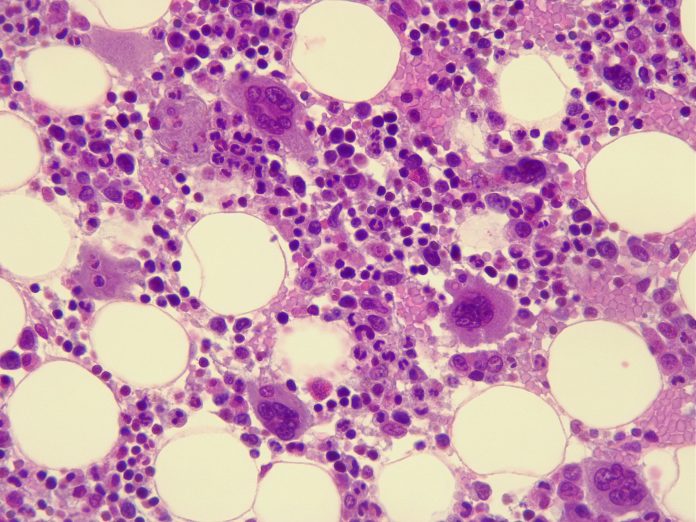
Results from a phase III trial show that the targeted cancer drug momelotinib is more effective than danazol in treating patients with myelofibrosis, especially those with anemia.
The trial results, published in The Lancet, show that the activin receptor IA/activin-like kinase 2 (ACVR1/ALK2) and Janus kinase (JAK)-1/2 inhibitor produced a greater reduction in total symptom score and less adverse effects than treatment with danazol, an androgen therapy used to treat some patients with this cancer.
Myelofibrosis is a type of rare bone marrow blood cancer, with about 1.5 cases reported per 100,000 people each year in the United States. Mutations in the JAK2, CALR, or MPL genes are often seen in patients with this condition.
“Dysregulated JAK-mediated signaling leading to uncontrolled clonal proliferation and elevated inflammatory cytokine production is characteristic of myelofibrosis and typically manifests as bone marrow fibrosis, anemia, splenomegaly, and debilitating symptoms,” write lead author Srdan Verstovsek, a professor at the University of Texas MD Anderson Cancer Center, and colleagues.
“JAK inhibitors approved for the treatment of myelofibrosis provide spleen and symptom improvements but fail to address—and might induce or worsen—anemia.”
The current study randomly assigned 195 JAK-inhibitor-exposed patients with primary myelofibrosis, or post-polycythemia vera or post-essential thrombocythemia myelofibrosis, to treatment with momelotinib (n=130) or danazol (n=65). The patients received treatment for 24 weeks.
The trial’s primary endpoint was reduction in symptoms after treatment, defined as a 50% or more reduction in Myelofibrosis Symptom Assessment Form Total Symptom Score. Overall, 25% of the momelotinib group achieved this compared with only 9% of the danazol group.
There was also a significant reduction in spleen volume after momelotinib treatment. In total, 40% of the momelotinib vs 6% of the danazol group achieved a size reduction of 25% or more. Transfusion independence rates also went up by 18% in the momelotinib group compared with 5% in the danazol group from baseline to 24 weeks.
Overall, side effects were lower in the momelotinib group than the danazol group. The most common non-blood related adverse effects experienced by trial participants in the momelotinib group included diarrhea, nausea, weakness and irritated skin.
“If approved, momelotinib could offer an effective option for patients with myelofibrosis to improve anemia, splenomegaly and other disease-related symptoms over other approved medications so far,” commented Verstovsek in a press statement.
“Momelotinib may also be an ideal partner for combinations with other investigational agents in development to further control myelofibrosis symptoms.”
Momelotinib is being developed by GSK and is not yet approved by the FDA, although the regulator accepted an application for approval from the company last year and a decision regarding approval is expected later this year.













